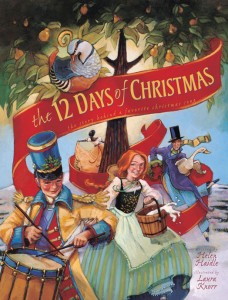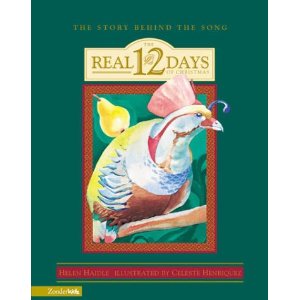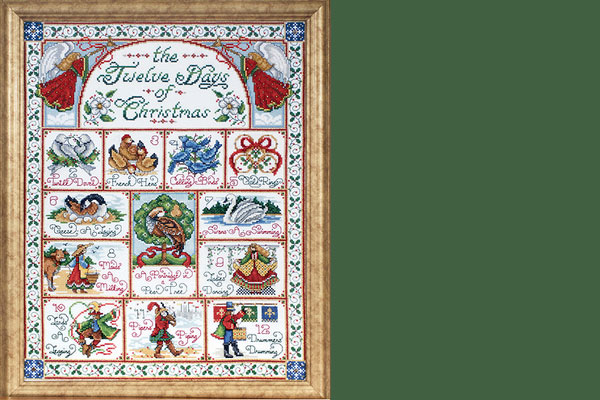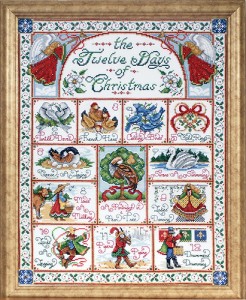The 12 Days of Christmas
This post may contain affiliate links, including those from Amazon.com, which means we earn a small commission off your purchases. And here's the thing: We only mention services and products that we think are truly worth your attention, whether they're free, paid, or otherwise. This site relies on YOUR trust, so if we don't stand behind a product 110%, it's not mentioned. Period.
The popular song “The Twelve Days of Christmas” is often thought of as a delightful-though-nonsensical part of the Christmas season. However, according to legend, it is actually a song used by Christian parents during the religious wars of the 16th century in England to teach their children the catechism clandestinely. Each symbol has a specific meaning to teach one part of the Christian faith. And whether or not this is historically accurate, I love the idea and the song can certainly be used in this fashion quite easily!
One commentator ((Dennis Bratcher)) said it best: ““While some have tried to debunk this as an “urban myth” out of personal agendas, others have tried to deal with this account of the song's origin in the name of historical accuracy (see Snopes on The 12 Days of Christmas). There is little “hard” evidence available either way. Some church historians affirm this account as basically accurate, while others point out apparent historical and logical discrepancies…
Perhaps, when all is said and done, historical accuracy is not really the point. Perhaps more important is that Christians can celebrate their rich heritage, and God's grace, through one more avenue this Christmas. Now, when they hear what they once thought was a secular ‘nonsense song,' they will be reminded in one more way of the grace of God working in transforming ways in their lives and in our world. After all, is that not the meaning of Christmas anyway?”
Also, it's a popular misconception that the Twelve Days of Christmas land before Christmas Day; rather they are the 12 days between Christmas and Epiphany, celebrated on January 6, the day when we celebrate the arrival of the wise men to worship and bring gifts to the baby Jesus. It's a fantastic season!
There are two wonderful books that we've used in our home to learn more about the song and to better understand the symbols. They are both authored by Helen Haidle, though differ in their tone. I urge you to check them out!
   | The 12 Days of Christmas: The Story Behind a Favorite Christmas Song This edition is published by ZonderKidz and has gorgeous illustrations. It is geared toward a younger audience and engages readers by asking questions throughout the text: “Do you know what a partridge is?” “Who does the partridge remind you of?” |
   | The Real 12 Days of Christmas |
“My True Love”
“My true love” refers to God Himself, the giver of all good gifts.
The First Day of Christmas – A Partridge in a Pear Tree
The partridge in a pear tree refers to Jesus. A mother partridge, when in the presence of a predator, is willing to risk injury and death to save her chicks. This image points to Christ's death on the cross to save his people and echoes Jesus' lament over Jerusalem: “Jerusalem, Jerusalem, you who kill the prophets and stone those sent to you, how often I have longed to gather your children together, as a hen gathers her chicks under her wings…” (Luke 13:34).
The Second Day of Christmas – Two Turtle Doves
The two turtle doves represent the Old and New Testaments, which together give the full story of God's creation, his love for his people, how his people broke their relationship with God, his plan to redeem them, and what is to come as they are reunited to God and how they will worship him forever.
The Third Day of Christmas – Three French Hens
There are two versions of what the three French hens stand for. Some say they are the three Biblical virtues the author Paul espoused in 1 Corinthians 13:13: Faith, Hope, and Love.
Others claim the three French hens represent the three precious gifts the Wise Men brought: gold, frankincense, and myrrh, and inspire us to bring our best to Christ.
The Fourth Day of Christmas – Four Calling Birds
The four calling birds stand for the four gospels that call all people to Christ.
The Fifth Day of Christmas – Five Golden Rings
The five golden rings represent the Torah, which Christians call the Pentateuch, the first five books of the Bible. These books give a rich history of God's people and point to God's grace in spite of their unfaithfulness.
The Sixth Day of Christmas – Six Geese A-Laying
The six geese represent the six days of creation.
The Seventh Day of Christmas – Seven Swans A-Swimming
The seven swans tell of the seven gifts the Holy Spirit gives, described in Romans 12:6-8: prophecy, service, teaching, exhortation, giving, leading and compassion.
The Eighth Day of Christmas – Eight Maids A-Milking
The eight maids are the eight Beatitudes Jesus preached in Matthew 5:3-10:
“Blessed are the poor in spirit, for theirs is the kingdom of heaven.
Blessed are those who mourn, for they will be comforted.
Blessed are the meek, for they will inherit the earth.
Blessed are those who hunger and thirst for righteousness, for they will be filled.
Blessed are the merciful, for they will be shown mercy.
Blessed are the pure in heart, for they will see God.
Blessed are the peacemakers, for they will be called children of God.
Blessed are those who are persecuted because of righteousness, for theirs is the kingdom of heaven.”
The Ninth Day of Christmas – Nine Ladies Dancing
The nine ladies are the nine Fruit of the Spirit that distinguishes the character of a follower of Christ: love, joy, peace, patience, kindness, generosity, faithfulness, gentleness, and self-control. (Galatians 5:22)
“Dancing” is an appropriate description for this day, I think, for when our lives are marked by these characteristics, our spirits can't help but want to dance!
The Tenth Day of Christmas – Ten Lords A-Leaping
The ten lords are the Ten Commandments God gives his people to show them how to live.
The Eleventh Day of Christmas – Eleven Pipers Piping
The eleven pipers are the eleven apostles who remained faithful to Jesus: Simon Peter, Andrew, James, John, Philip, Bartholomew, Matthew, Thomas, James son of Alphaeus, Simon the Zealot, and Judas son of James. The number of apostles is eleven, not twelve, because the twelfth, Judas Iscariot, betrayed Jesus.
The Twelfth Day of Christmas – Twelve Drummers Drumming
The Apostles' Creed, one of the most widely accepted creeds across Christendom, includes twelve points of doctrine that outline what Christians believe:
- 1. I believe in God, the Father almighty, creator of heaven and earth.
- 2. I believe in Jesus Christ, his only Son, our Lord.
- 3. He was conceived by the power of the Holy Spirit and born of the Virgin Mary.
- 4. He suffered under Pontius Pilate, was crucified, died, and was buried.
- 5. He descended to the dead. On the third day he rose again.
- 6. He ascended into heaven and is seated at the right hand of the Father.
- 7. He will come again to judge the living and the dead.
- 8. I believe in the Holy Spirit,
- 9. the holy catholic Church, the communion of saints,
- 10. the forgiveness of sins,
- 11. the resurrection of the body,
- 12. and life everlasting.
- Amen.






Thank you for this! I was just planning on looking up this songs meaning and here it was in my email 🙂 I have also heard that the 12 Days of Christmas represents the 12 Tribes of Israel! So much meaning to a song we sing all the time.
I LOVE this! Thank you 🙂
This is probably the “coolest” thing I’ve read all season. Thank you so much for sharing this 🙂 Happy New Year!
Sorry to burst your bubble, but according to Wikipedia:
In 1979, a Canadian hymnologist, Hugh D. McKellar, published an article, “How to Decode the Twelve Days of Christmas”, claiming that “The Twelve Days of Christmas” lyrics were intended as a catechism song to help young Catholics learn their faith, at a time when practising Catholicism was criminalized in England (1558 until 1829). McKellar offered no evidence for his claim and subsequently admitted that the purported associations were his own invention.[27] The idea was further popularized by a Catholic priest, Fr. Hal Stockert, in an article he wrote in 1982 and posted online in 1995,[28][29] In 1987 and 1992, Fr. James Gilhooley, chaplain of Mount Saint Mary College of Newburgh, New York repeated these claims.[30][31] None of the enumerated items would distinguish Catholics from Protestants, and so would hardly need to be secretly encoded.[3]
See the original article to access sources:
http://en.wikipedia.org/wiki/The_Twelve_Days_of_Christmas_(song)
Exactly! Which is why I include this specific quote in the article above:
“While some have tried to debunk this as an “urban myth” out of personal agendas, others have tried to deal with this account of the song’s origin in the name of historical accuracy (see Snopes on The 12 Days of Christmas). There is little “hard” evidence available either way. Some church historians affirm this account as basically accurate, while others point out apparent historical and logical discrepancies…
Perhaps, when all is said and done, historical accuracy is not really the point. Perhaps more important is that Christians can celebrate their rich heritage, and God’s grace, through one more avenue this Christmas. Now, when they hear what they once thought was a secular ‘nonsense song,’ they will be reminded in one more way of the grace of God working in transforming ways in their lives and in our world. After all, is that not the meaning of Christmas anyway?”
There is no bubble to burst. 😉
i was thinking, too, that the Three French Hens might stand for the Trinity: the Father, the Son, and the Holy Ghost. Thanks, I learned new things today.
Beautiful!! Thank you so much for sharing!!
Merry Christmas to you and your family!!
Thank you for your passion of research! Love the ways you add scripture to support the symbolism of the song and true meaning! God Bless You and your family.